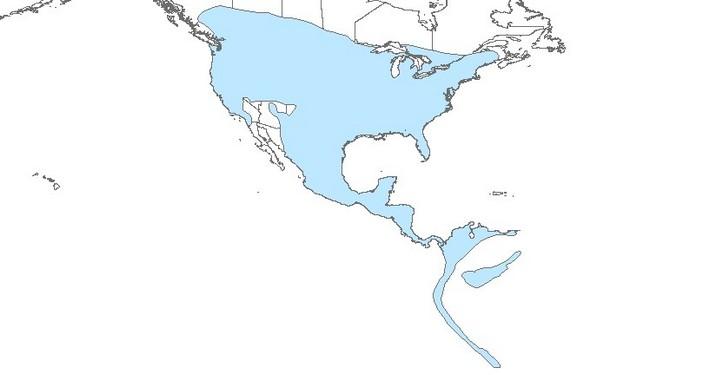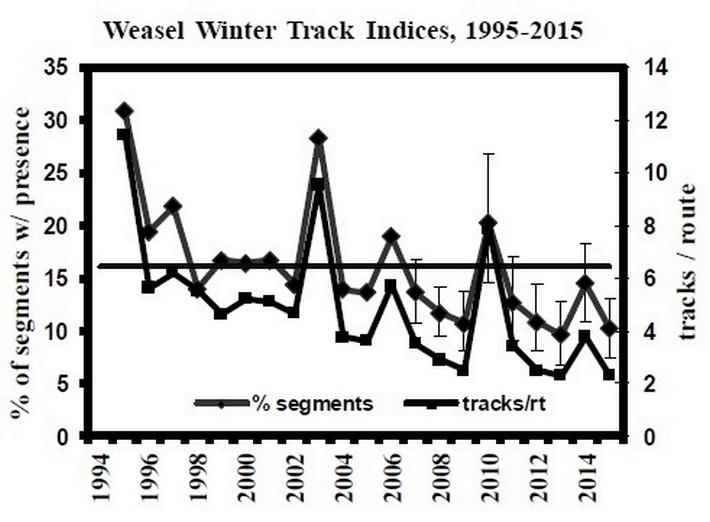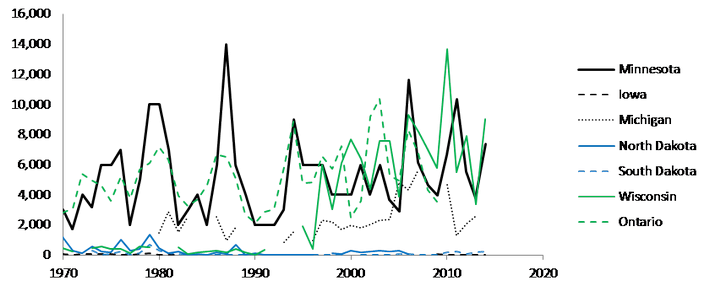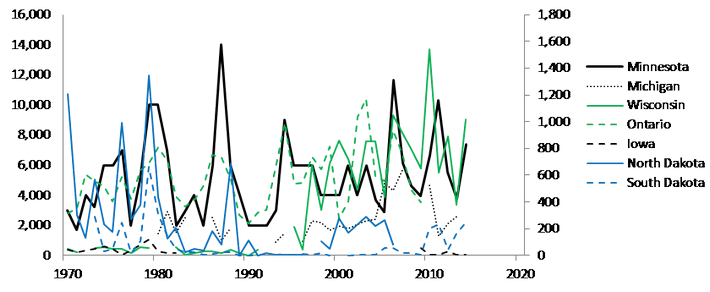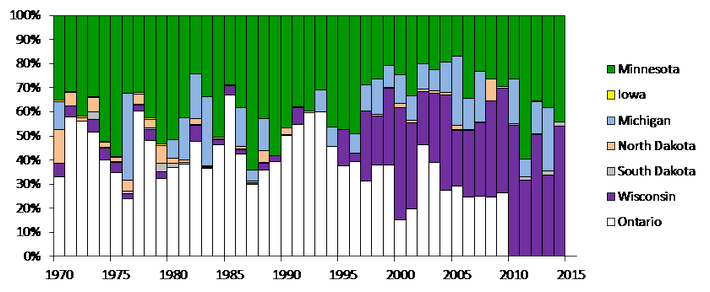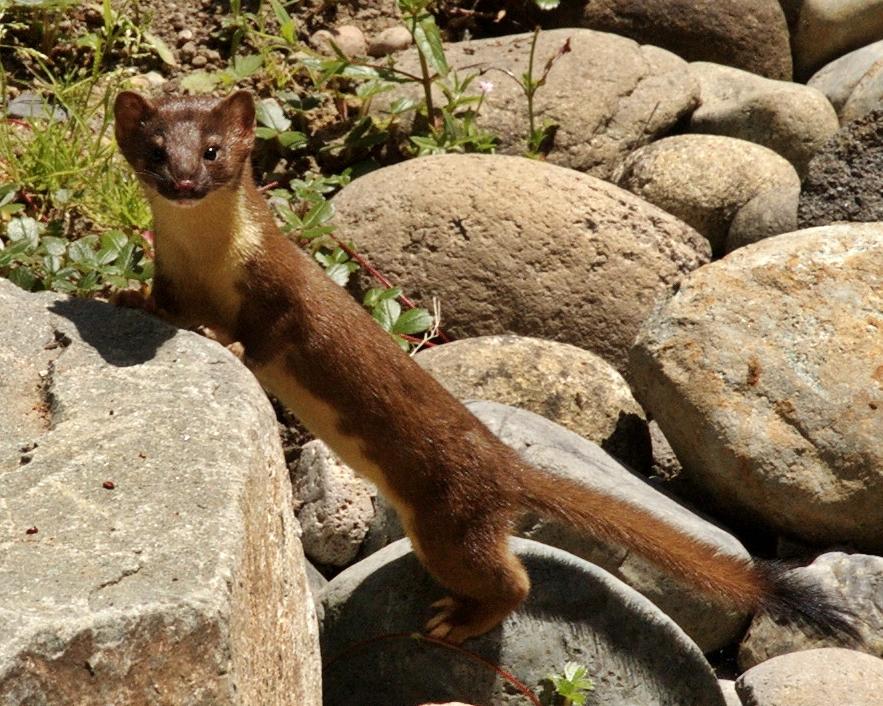
Description
Long-tailed weasels are small carnivores in the weasel family (Mustelidae). The major identification challenge is distinguishing long-tailed weasels from ermine and least weasels.
Long-tailed weasels are largest (total length 300-350 mm), ermine are medium sized (total length males 225-340 mm, females 190-290 mm), while least weasels are smallest (total length less than 250 mm in males and less than 225 mm in females; Svendsen, 1982). Long-tailed weasels have a tail longer than half their body length with a black tip, ermine have a tail length around a third of their body length with a black tip, and least weasels have a tail length around a quarter of their body length and lack a black tip. Only least weasel fur will fluoresce under ultraviolet light. Ermine and long-tailed weasels are more commonly detected in much of the Great lakes region, with least weasels less common.
Size
Measurements from Minnesota are from Hazard (1982), and from Wisconsin are from Jackson (1961).
Male total length averaged 16.7” (425 mm) in Minnesota, ranged from 13.7” to 17.7” (348-450 mm) in Minnesota, and ranged from 13.8” to 17.0” (350-431 mm) in Wisconsin.
Female total length averaged 14.0” (356 mm) in Minnesota, ranged from 11.9” to 16.2” (302-412 mm) in Minnesota, and ranged from 11.2” to 13.4” (285-340 mm) in Wisconsin.
Male tail length averaged 6.0” (152 mm) in Minnesota, ranged from 5.2” to 6.5” (131-165 mm) in Minnesota, and ranged from 4.5” to 5.9” (115-150 mm) in Wisconsin.
Female tail length averaged 4.2” (107 mm) in Minnesota, ranged from 3.8” to 5.5” (96-139 mm), and ranged from 3.3” to 4.8” (85-123 mm) in Wisconsin.
Male body weight averaged 0.7 lb (316 g) in Minnesota, ranged from 0.5 to 0.9 lb (243-419 g) in Minnesota, and ranged from 0.4 to 0.5 lb (170-245 g) in Wisconsin.
Female body weight averaged 0.4 lb (198 g) in Minnesota, ranged from 0.2 to 0.6 lb (103-276 g) in Minnesota, and ranged from 0.2 to 0.3 lb (85-130 g) in Wisconsin.
Males are typically larger than females.
Distribution & Status
Long-tailed weasels are found from southern Canada to northern South America, except for portions of the southwestern U.S. Populations are secure or apparently secure throughout the Great Lakes region.
Worldwide, Mustela frenata is the most widespread weasel species in the Western Hemisphere. Other Mustela species occur throughout the world, except for Australia, Antarctica, and most oceanic islands.
Long-tailed weasels have an IUCN rank of Least Concern, IUCN information.
Incidence in Minnesota
Weasels, including long-tailed weasels, are classified as unprotected species in Minnesota. Hunting and trapping are regulated by the Minnesota Department of Natural Resources, regulations.
From winter track data (1994-2015) it appears that Minnesota weasel populations are declining (Erb, 2015).
Population Trends
To help assess population trends, we can look at regional furbearer harvest data, methods.
Harvest data for ermines, long-tailed weasels, and least weasels are pooled as “weasels”, making it difficult to isolate individual species trends. Of the three pooled species, ermine are the most abundant over most of the Great Lakes region. There is a lot of year-to-year variation in harvest, making it difficult to detect any long-term trends.
Minnesota and Ontario dominate regional harvest, with Wisconsin harvest increasing significantly since the mid-1990s.
Life History
Long-tailed weasels primarily feed on voles and mice, but will also take other small mammals. Long-tailed weasels breed in mid-summer, but have a delayed implantation, with a resulting 7-11 month gestation. Females bear 4-8 young in April-May, with young eyes and ears opening at 5 weeks, attain adult body weight in 3-4 months, and young disperse by the end of summer. Dens are in holes in the ground, in banks, under logs, or under rocks. Long-tailed weasels will cache excess food for later use. Long-tailed weasels in northern climes are brown in summer, and turn white in winter. Long-tailed weasels are prey for raptors, larger mammal carnivores, and snakes.
Contacts with Humans
Weasels are trapped for their pelts. Weasels are sometimes viewed as threats to poultry operations, but rarely attack domestic fowl. Weasels help control mice, voles, and other small mammal populations that can be pest species to humans.
